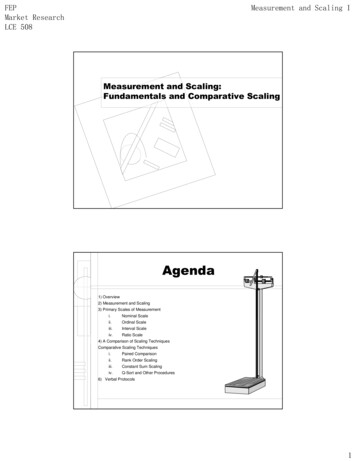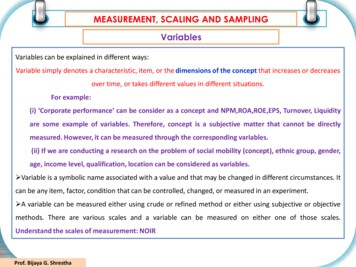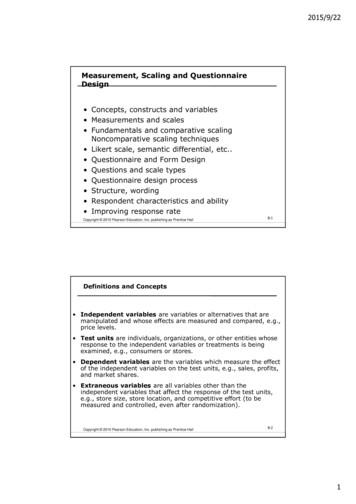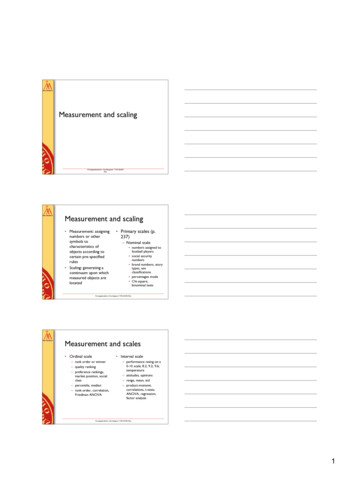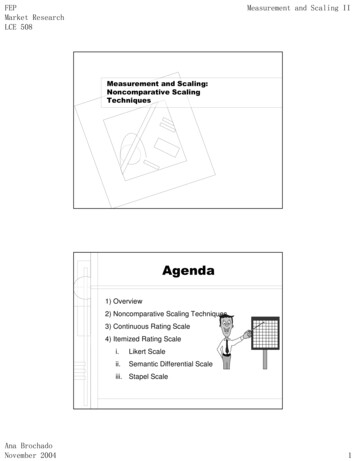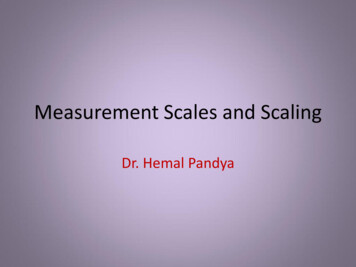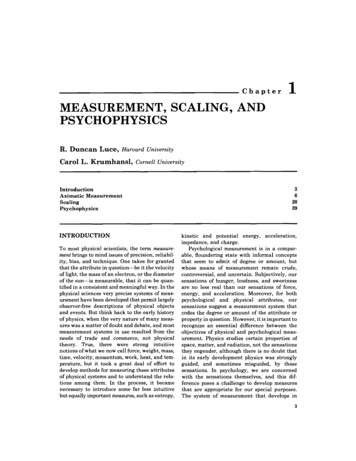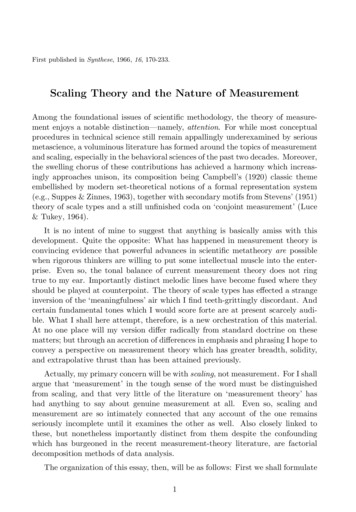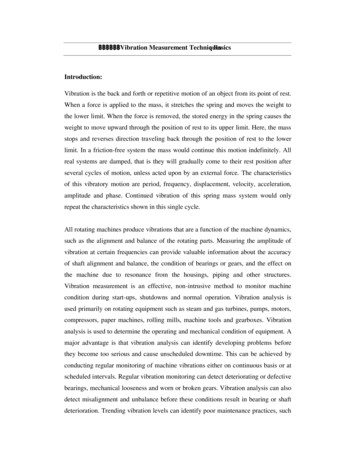
Transcription
Measurement and Scaling TechniquesMeasurement In ResearchIn our daily life we are said to measure when we use some yardstick to determineweight, height, or some other feature of a physical object. We also measure when wejudge how well we like a song, a painting or the personalities of our friends. We, thus,measure physical objects as well as abstract concepts. Measurement is a relativelycomplex and demanding task, specially so when it concerns qualitative or abstractphenomena. By measurement we mean the process of assigning numbers to objects orobservations, the level of measurement being a function of the rules under which thenumbersareassigned.It is easy to assign numbers in respect of properties of some objects, but it is relativelydifficult in respect of others. For instance, measuring such things as social conformity,intelligence, or marital adjustment is much less obvious and requires much closerattention than measuring physical weight, biological age or a person’s financial assets.In other words, properties like weight, height, etc., can be measured directly withsome standard unit of measurement, but it is not that easy to measure properties likemotivation to succeed, ability to stand stress and the like. We can expect highaccuracy in measuring the length of pipe with a yard stick, but if the concept isabstract and the measurement tools are not standardized, we are less confident lly speaking, measurement is a process of mapping aspects of a domain ontoother aspects of a range according to some rule of correspondence. In measuring, wedevise some form of scale in the range (in terms of set theory, range may refer tosome set) and then transform or map the properties of objects from the domain (interms of set theory, domain may refer to some other set) onto this scale. For example,in case we are to find the male to female attendance ratio while conducting a study ofpersons who attend some show, then we may tabulate those who come to the showaccording to sex. In terms of set theory, this process is one of mapping the observed
physical properties of those coming to the show (the domain) on to a sex classification(the range). The rule of correspondence is: If the object in the domain appears to bemale, assign to “0” and if female assign to “1”. Similarly, we can record a person’smarital status as 1, 2, 3 or 4, depending on whether the person is single, married,widowed or divorced. We can as well record “Yes or No” answers to a question as“0” and “1” (or as 1 and 2 or perhaps as 59 and 60). In this artificial or nominal way,categorical data (qualitative or descriptive) can be made into numerical data and if wethus code the various categories, we refer to the numbers we record as nominal data.Nominal data are numerical in name only, because they do not share any of theproperties of the numbers we deal in ordinary arithmetic. For instance if we recordmarital status as 1, 2, 3, or 4 as stated above, we cannot write 4 2 or 3 4 and wecannotwrite3–1 4–2,1 3 4or4 2 2.In those situations when we cannot do anything except set up inequalities, we refer tothe data as ordinal data. For instance, if one mineral can scratch another, it receives ahigher hardness number and on Mohs’ scale the numbers from 1 to 10 are assignedrespectively to talc, gypsum, calcite, fluorite, apatite, feldspar, quartz, topaz, sapphireand diamond. With these numbers we can write 5 2 or 6 9 as apatite is harder thangypsum and feldspar is softer than sapphire, but we cannot write for example 10 – 9 5 – 4, because the difference in hardness between diamond and sapphire is actuallymuch greater than that between apatite and fluorite. It would also be meaningless tosay that topaz is twice as hard as fluorite simply because their respective hardnessnumbers on Mohs’ scale are 8 and 4. The greater than symbol (i.e., ) in connectionwith ordinal data may be used to designate “happier than” “preferred to” and so on.When in addition to setting up inequalities we can also form differences, we refer tothe data as interval data. Suppose we are given the following temperature readings (indegrees Fahrenheit): 58 , 63 , 70 , 95 , 110 , 126 and 135 . In this case, we canwrite 100 70 or 95 135 which simply means that 110 is warmer than 70 andthat 95 is cooler than 135 . We can also write for example 95 – 70 135 – 110 ,
since equal temperature differences are equal in the sense that the same amount ofheat is required to raise the temperature of an object from 70 to 95 or from 110 to135 . On the other hand, it would not mean much if we said that 126 is twice as hotas 63 , even though 126 63 2. To show the reason, we have only to change to thecentigrade scale, where the first temperature becomes 5/9 (126 – 32) 52 , the secondtemperature becomes 5/9 (63 – 32) 17 and the first figure is now more than threetimes the second. This difficulty arises from the fact that Fahrenheit and Centigradescales both have artificial origins (zeros) i.e., the number 0 of neither scale isindicative of the absence of whatever quantity we are trying to measure.When in addition to setting up inequalities and forming differences we can also formquotients (i.e., when we can perform all the customary operations of mathematics), werefer to such data as ratio data. In this sense, ratio data includes all the usualmeasurement (or determinations) of length, height, money amounts, weight, volume,area,pressuresetc.The above stated distinction between nominal, ordinal, interval and ratio data isimportant for the nature of a set of data may suggest the use of particular statisticaltechniques*. A researcher has to be quite alert about this aspect while measuringproperties of objects or of abstract concepts.Measurement ScalesFrom what has been stated above, we can write that scales of measurement can beconsidered in terms of their mathematical properties. The most widely usedclassification of measurement scales are: nominal scale ordinal scale interval scale and ratio scale.
Nominal scale: Nominal scale is simply a system of assigning number symbolsto events in order to label them. The usual example of this is the assignment ofnumbers of basketball players in order to identify them. Such numbers cannotbe considered to be associated with an ordered scale for their order is of noconsequence; the numbers are just convenient labels for the particular class ofevents and as such have no quantitative value. Nominal scales provideconvenient ways of keeping track of people, objects and events. One cannot domuch with the numbers involved. For example, one cannot usefully average thenumbers on the back of a group of football players and come up with ameaningful value. Neither can one usefully compare the numbers assigned toone group with the numbers assigned to another. The counting of members ineach group is the only possible arithmetic operation when a nominal scale isemployed. Accordingly, we are restricted to use mode as the measure of centraltendency. There is no generally used measure of dispersion for nominal scales.Chi-square test is the most common test of statistical significance that can beutilized, and for the measures of correlation, the contingency coefficient can beworkedout.Nominal scale is the least powerful level of measurement. It indicates no orderor distance relationship and has no arithmetic origin. A nominal scale simplydescribes differences between things by assigning them to categories. Nominaldata are, thus, counted data. The scale wastes any information that we mayhave about varying degrees of attitude, skills, understandings, etc. In spite of allthis, nominal scales are still very useful and are widely used in surveys andother ex-post-facto research when data are being classified by major sub-groupsof the population. Ordinal scale: The lowest level of the ordered scale that is commonly used isthe ordinal scale. The ordinal scale places events in order, but there is noattempt to make the intervals of the scale equal in terms of some rule. Rankorders represent ordinal scales and are frequently used in research relating toqualitative phenomena. A student’s rank in his graduation class involves theuse of an ordinal scale. One has to be very careful in making statement aboutscores based on ordinal scales. For instance, if Ram’s position in his class is 10and Mohan’s position is 40, it cannot be said that Ram’s position is four timesas good as that of Mohan. The statement would make no sense at all. Ordinalscales only permit the ranking of items from highest to lowest. Ordinal
measures have no absolute values, and the real differences between adjacentranks may not be equal. All that can be said is that one person is higher orlower on the scale than another, but more precise comparisons cannot be made.Thus, the use of an ordinal scale implies a statement of ‘greater than’ or ‘lessthan’ (an equality statement is also acceptable) without our being able to statehow much greater or less. The real difference between ranks 1 and 2 may bemore or less than the difference between ranks 5 and 6. Since the numbers ofthis scale have only a rank meaning, the appropriate measure of centraltendency is the median. A percentile or quartile measure is used for measuringdispersion. Correlations are restricted to various rank order methods. Measuresof statistical significance are restricted to the non-parametric methods. Interval scale: In the case of interval scale, the intervals are adjusted in termsof some rule that has been established as a basis for making the units equal. Theunits are equal only in so far as one accepts the assumptions on which the ruleis based. Interval scales can have an arbitrary zero, but it is not possible todetermine for them what may be called an absolute zero or the unique origin.The primary limitation of the interval scale is the lack of a true zero; it does nothave the capacity to measure the complete absence of a trait or characteristic.The Fahrenheit scale is an example of an interval scale and shows similaritiesin what one can and cannot do with it. One can say that an increase intemperature from 30 to 40 involves the same increase in temperature as anincrease from 60 to 70 , but one cannot say that the temperature of 60 istwice as warm as the temperature of 30 because both numbers are dependenton the fact that the zero on the scale is set arbitrarily at the temperature of thefreezing point of water. The ratio of the two temperatures, 30 and 60 , meansnothingbecausezeroisanarbitrarypoint.Interval scales provide more powerful measurement than ordinal scales forinterval scale also incorporates the concept of equality of interval. As suchmore powerful statistical measures can be used with interval scales. Mean is theappropriate measure of central tendency, while standard deviation is the mostwidely used measure of dispersion. Product moment correlation techniques areappropriate and the generally used tests for statistical significance are the ‘t’test and ‘F’ test. Ratio scale: Ratio scales have an absolute or true zero of measurement. Theterm ‘absolute zero’ is not as precise as it was once believed to be. We can
conceive of an absolute zero of length and similarly we can conceive of anabsolute zero of time. For example, the zero point on a centimeter scaleindicates the complete absence of length or height. But an absolute zero oftemperature is theoretically unobtainable and it remains a concept existing onlyin the scientist’s mind. The number of minor traffic-rule violations and thenumber of incorrect letters in a page of type script represent scores on ratioscales. Both these scales have absolute zeros and as such all minor trafficviolations and all typing errors can be assumed to be equal in significance.With ratio scales involved one can make statements like “Jyoti’s” typingperformance was twice as good as that of “Reetu.” The ratio involved doeshave significance and facilitates a kind of comparison which is not possible incaseofanintervalscale.Ratio scale represents the actual amounts of variables. Measures of physicaldimensions such as weight, height, distance, etc. are examples. Generally, allstatistical techniques are usable with ratio scales and all manipulations that onecan carry out with real numbers can also be carried out with ratio scale values.Multiplication and division can be used with this scale but not with other scalesmentioned above. Geometric and harmonic means can be used as measures ofcentral tendency and coefficients of variation may also be calculated.Thus, proceeding from the nominal scale (the least precise type of scale) toratio scale (the most precise), relevant information is obtained increasingly. Ifthe nature of the variables permits, the researcher should use the scale thatprovides the most precise description. Researchers in physical sciences havethe advantage to describe variables in ratio scale form but the behavioralsciences are generally limited to describe variables in interval scale form, a lessprecise type of measurement.Sources of Error in MeasurementMeasurement should be precise and unambiguous in an ideal research study. Thisobjective, however, is often not met with in entirety. As such the researcher must beaware about the sources of error in measurement. The following are the possiblesources of error in measurement. Respondent: At times the respondent may be reluctant to express strongnegative feelings or it is just possible that he may have very little knowledgebut may not admit his ignorance. All this reluctance is likely to result in an
interview of ‘guesses.’ Transient factors like fatigue, boredom, anxiety, etc.may limit the ability of the respondent to respond accurately and fully. Situation: Situational factors may also come in the way of correctmeasurement. Any condition which places a strain on interview can haveserious ef
Measurement and Scaling Techniques Measurement In Research In our daily life we are said to measure when we use some yardstick to determine weight, height, or some other feature of a physical object. We also measure when we judge how well we like a song, a File Size: 216KBPage Count: 23
